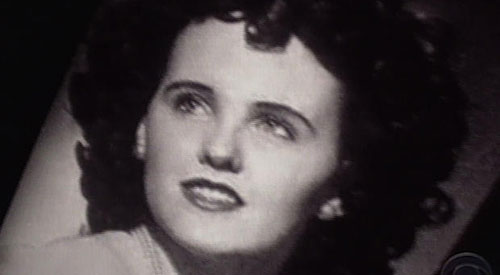

(PCM) It was on January 15, 1947 that one of the country’s most famous unsolved murder cases began with the discovery of the mutilated corpse of waitress Elizabeth Short in Leimert Park, Los Angeles, California. The investigation into Short’s murder was very highly publicized and it earned the nickname “The Black Dahlia” which is said to be derived from a film noir murder mystery.
Over the years there has been countless suspects and theories about just who committed the grisly murder, as Short’s body was found cut in half from the torso and her face was craved with Glasgow smile cut from mouth to ears. The body was drained of all its’ blood and the body appeared to have been washed by the killer. The lower half of her body was positioned a foot away from the upper, and her intestines had been tucked neatly beneath her buttocks. The corpse had been “posed,” with her hands over her head, her elbows bent at right angles, and her legs spread apart. Detectives found a cement sack nearby containing watery blood. There was a heel print on the ground amid the tire tracks, but they were never able to tie anyone to the horrific crime.
There have been several books, TV and film adaptions of the story and it is the oldest unsolved crime in history of Los Angeles. According to several sources, following Short’s identification, reporters from the Los Angeles Examiner contacted her mother, Phoebe Short, and told her that her daughter had won a beauty contest. Only after prying as much personal information as they could from Mrs. Short, did the reporters tell her that her daughter had been murdered. The newspaper offered to pay her air fare and accommodations, if she would travel to Los Angeles to help with the police investigation. That was yet another ploy, since the newspaper kept her away from police and other reporters to protect its scoop.William Randolph Hearst’s papers, the Los Angeles Herald-Express and the Los Angeles Examiner, later sensationalized the case: the black tailored suit Short was last seen wearing became “a tight skirt and a sheer blouse,” and Elizabeth Short became the “Black Dahlia,” an “adventuress” who “prowled Hollywood Boulevard.”
On January 23, 1947, a person claiming to be the killer called the editor of the Los Angeles Examiner, expressing concern that news of the murder was tailing off and offering to mail items belonging to Short to the editor. The following day, a packet arrived at the Los Angeles newspaper containing Short’s birth certificate, business cards, photographs, names written on pieces of paper, and an address book with the name Mark Hansen embossed on the cover. Hansen, an acquaintance at whose home she had stayed with friends, immediately became a suspect. On January 25, Short’s handbag and one shoe were reported seen on top of a garbage can in an alley a short distance from Norton Avenue. They were finally located at the dump.
Due to the notoriety of the case, over the years more than 50 men and women have confessed to the murder, and police are swamped with tips every time a newspaper mentions the case or a book or movie is released about it. Each and every time police have been able to rule out the suspects for various reasons and have yet to convict anyone for the crime. It is most definitely the mystery and the intrigue of this case that has immortalized “The Black Dahlia” murder, as there continues to be a strong fascination with her life and the gruesome way in which she was killed. Many are still searching for answers, but sadly given the amount of time that has passed we may never learn the truth.
The post The Body Of “The Black Dahlia” a.k.a. Elizabeth Short Was Discovered On January 15, 1947 appeared first on Weird But True News.
